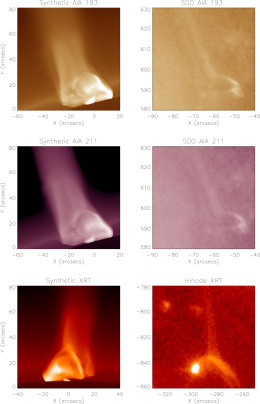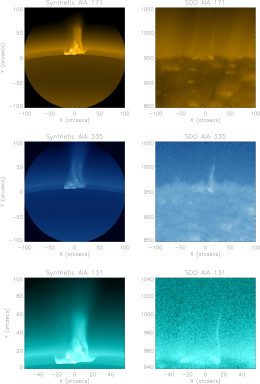
Formation of a coronal jet from twisted field lines that have reconnected with the ambient field. The colors show the radial velocity of the plasma. [Adapted from Szente et al. 2017]
Small Explosions
Coronal jets are relatively small eruptions from the Sun’s surface, with heights of roughly 100 to 10,000 km, speeds of 10 to 1,000 km/s, and lifetimes of a few minutes to around ten hours. These jets are constantly present — they’re emitted even from the quiet Sun, when activity is otherwise low — and we’ve observed them with a fleet of Sun-watching space telescopes spanning the visible, extreme ultraviolet (EUV), and X-ray wavelength bands.

A comparison of simulated observations based on the authors’ model (left panels) to actual EUV and X-ray observations of jets (right panels). [Szente et al. 2017]
Launching a Jet
Led by Judit Szente (University of Michigan), a team of scientists has explored the impact of coronal jets on the global corona and solar wind with a series of numerical simulations. Szente and collaborators used three-dimensional, magnetohydrodynamic simulations that provide realistic treatment of the solar atmosphere, the solar wind acceleration, and the complexities of heat transfer throughout the corona.
In the authors’ simulations, a jet is initiated as a magnetic dipole rotates at the solar surface, winding up field lines. Magnetic reconnection between the twisted lines and the background field then launches the jet from the dense and hot solar chromosphere, and erupting plasma is released outward into the solar corona.

A second comparison of simulated observations based on the authors’ model (left panels) to actual EUV observations of jets (right panels). [Szente et al. 2017]
Global Influences
After demonstrating that their models could successfully lead to jet production and propagation, Szente and collaborators compared their results to actual observations of solar jets. The authors constructed simulated EUV and X-ray observations of their modeled events, and they verified that the behavior and structures in these simulated observations were very similar to real observations of coronal jet events from telescopes like SDO/AIA and Hinode.
With this confirmed, the authors then used their models to determine how the jets influence the global solar corona and the solar wind. They found that the large-scale corona is significantly affected by the plasma waves from the jet, which travel across 40° in latitude and out to 24 solar radii. In spite of this, the simulated jets contributed only a few percent to the steady-state solar-wind energy outflow.
These simulations represent an important step in realistic modeling of the quiet Sun. Because the models make specific predictions about temperature and density gradients within the corona, we can look forward to testing them with upcoming missions like Solar Probe Plus, which should be able to explore the Sun all the way down to nine solar radii.
Citation
J. Szente et al 2017 ApJ 834 123. doi:10.3847/1538-4357/834/2/123

